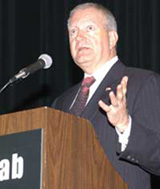 |
|
OSTP's Marburger Visits Fermilab by Judy Jackson
“Experiment is driving theory at this moment,” Marburger said. “We need
data. The Standard Model is great, but it is exciting to move into areas that
are not predicted. All eyes are on this lab, watching for data. I wish I could
stay here and work with you. The excitement of your discoveries will
propagate through society.”
Marburger made his remarks during a day-long visit to Fermilab on August 1,
in which he met with lab managers, addressed the Fermilab community and
kicked the tires on a tour of CDF and the Technical Division’s LHC magnet
center.
Discussions during the visit frequently centered on how to convey
Marburger’s excitement about particle physics to others in government.
He acknowledged the challenges currently confronting the field of particle
physics, in particular the re-evaluation of the rationale for physics funding
at national laboratories following the end of the Cold War and the long-term
nature of the payoffs from basic science.
“The old Cold War rationale for science was replaced by an economic
rationale,” he said. “This was scary to basic science, because investment
criteria often require short-term payoffs. Basic science rarely creates new
technology for immediate goals.”
“Congress is ready to support basic science,”
Marburger said, “but the economy must be strong
enough. And there are so many opportunities in
basic science that you may have to stand in line,
and you must prioritize. High energy physics has
done a good job of identifying priorities, and it
should get funded. It does get more expensive,
so we must look for new ways to fund it by
collaborating to spread the costs among many
nations.”
"We need to get across a better understanding of how this science works."
In response to a question from Fermilab physicist
Robert Bernstein, Marburger said he thought
particle physicists had done a good job of
educating others about the science that they
do, but had not yet succeeded in conveying
“how the science gets done” within government
agencies. Until he began serving as OSTP director
in mid-September 2001, Marburger, a physicist,
was director of the Department of Energy’s
Brookhaven National Laboratory. His comments
reflected a keen grasp of the funding challenges
for physics research at national laboratories.
“Few in Congress understand that DOE owns
about half of the physical sciences,” Marburger
said. “Congress supports basic science, but they
need to know what to fund in order to get the
desired result. Who thinks about the Department
of Energy in terms of cosmology and the Standard
Model? We need to get across a better
understanding of how this science works.”
In the area of potential roadblocks to international
science collaboration as a result of visa restrictions
in response to terrorist actions, Marburger said
OSTP might be able to help.
“For big science projects, such as those in highenergy
physics and astrophysics, international
collaboration is regarded as essential,” Marburger
said. “The Office of Science and Technology Policy
tries to get involved when we hear of a proposal
to hinder international collaboration. We try to
forestall it, not just as a matter of sharing the cost,
but because of the value of people from many
countries collaborating on science. We are
concerned about not over-reacting to the threat
of terrorism and inadvertently shutting doors to
contributions from foreign scientists. This is a
delicate time. We try to help broker the needs
of science and security.”
On the Web:
|
 I am personally excited about particle physics,” John Marburger, the Bush
Administration’s director of the Office of Science and Technology Policy, told
a Fermilab audience earlier this month. Furthermore, he said, now is a great
time to be a particle physicist.
I am personally excited about particle physics,” John Marburger, the Bush
Administration’s director of the Office of Science and Technology Policy, told
a Fermilab audience earlier this month. Furthermore, he said, now is a great
time to be a particle physicist. Nevertheless, Marburger urged listeners not to bemoan the shrinking
funding levels for the physical sciences, in particular particle physics, but
to concentrate instead on the scientific opportunities that will come from
increased investment in the field. He stressed the link between particle
physics and cosmology and urged particle physicists to make the case more
clearly for the connection between research at the largest and smallest
scales of nature, pointing to potential benefits from increased coordination
of high energy physics and the space program. He said he believes the case
for science has been made well in Congress and the administration, and that
it has met with a positive response.“
Nevertheless, Marburger urged listeners not to bemoan the shrinking
funding levels for the physical sciences, in particular particle physics, but
to concentrate instead on the scientific opportunities that will come from
increased investment in the field. He stressed the link between particle
physics and cosmology and urged particle physicists to make the case more
clearly for the connection between research at the largest and smallest
scales of nature, pointing to potential benefits from increased coordination
of high energy physics and the space program. He said he believes the case
for science has been made well in Congress and the administration, and that
it has met with a positive response.“